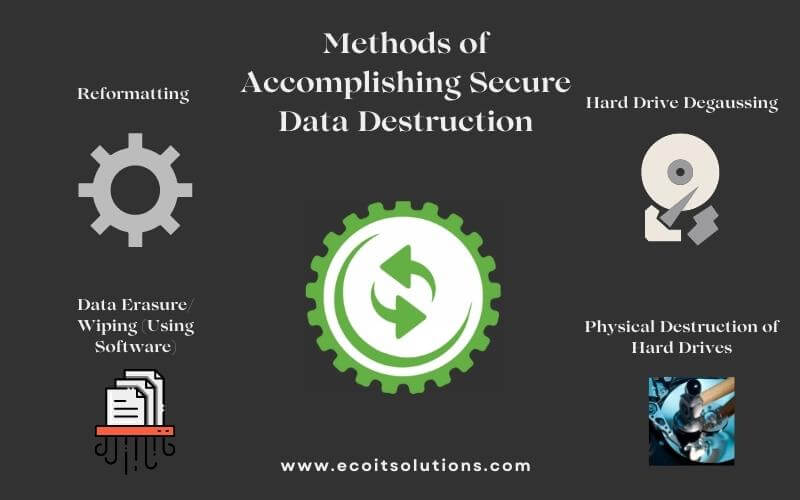Just How Appropriate Data Devastation Adds to Robust Computer System Protection Providers and Mitigates Dangers of Information Breaches
In today's electronic landscape, the significance of proper information destruction can not be overstated, as it offers as an essential element of thorough computer protection services. The implications of insufficient information damage expand past simple compliance; they can exceptionally influence a company's cybersecurity stance and reputation.
Relevance of Information Damage
In today's digital landscape, the significance of information damage can not be overemphasized. As companies increasingly count on digital properties, the possible dangers linked with data violations and unauthorized accessibility magnify. Efficient information devastation is an important part of an extensive details security approach, safeguarding sensitive info from dropping into the hands of harmful stars.
When data is no much longer needed, merely deleting data or formatting tough drives is inadequate. Recurring information can frequently be recuperated making use of readily available tools, positioning significant risks to both people and organizations. This underscores the necessity for robust information destruction methods that ensure all data is irretrievably erased.
Moreover, regulative compliance requireds, such as GDPR and HIPAA, emphasize the obligation to protect sensitive information, including its proper disposal. Non-compliance can bring about extreme lawful repercussions and economic penalties. data destruction. Hence, integrating reliable data damage methods not just improves safety and security however additionally strengthens an organization's track record and credibility

Methods of Secure Information Erasure
Several effective techniques of safe information erasure can be used to ensure that sensitive information is permanently gotten rid of from storage space tools. One widely identified approach is information overwriting, which entails replacing existing data with random patterns several times. This method substantially reduces the possibilities of information healing, although it might not be reliable versus sophisticated forensic methods.

Physical destruction is likewise a reliable strategy, where storage tools are rendered unusable through shredding, crushing, or incineration. This approach ensures that data can not be recovered whatsoever however calls for mindful handling of harmful materials.
Finally, specialized software program devices created for secure information erasure offer capabilities that follow various erasure criteria. These tools commonly include functions like verification procedures to confirm successful information devastation.
Employing these approaches in combination can improve data protection and mitigate the risks linked with data violations, ensuring that delicate details is not unintentionally exposed.
Legal and Compliance Factors To Consider
The techniques employed for safe data erasure not just offer to shield sensitive information but also must align with legal and conformity structures controling data protection. Organizations are called for to comply with different policies, such as the General Information Defense Law (GDPR), the Medical Insurance Mobility and Liability Act (HIPAA), and the Settlement Card Sector Information Safety And Security Criterion (PCI DSS) These laws mandate certain methods for data managing and destruction, making certain that personal and sensitive data is irretrievably gotten rid of when no longer required.
Failure to comply with these legal requirements can lead to considerable charges, including penalties and reputational damage. Additionally, companies must maintain records of information damage procedures, demonstrating conformity during audits or investigations. This documents not just shields versus legal effects however also strengthens trust fund with stakeholders and customers, showcasing a commitment to information security.
Integrating lawful and compliance factors to consider into data destruction methods is necessary for any organization. It reduces the risk of data breaches and illustrates a positive strategy to protecting delicate details, ultimately fostering a culture of protection and accountability across the company.
Influence On Cybersecurity Pose
Effective information damage substantially improves an organization's cybersecurity posture by minimizing the prospective strike surface area for cyber dangers. When sensitive data is not appropriately ruined, it continues to be available to malicious stars who can manipulate this information for unauthorized accessibility, identification theft, or corporate reconnaissance. By carrying out durable information devastation protocols, companies can effectively minimize the risk of data violations and enhance their overall protection structure.
Moreover, the safe and secure disposal of outdated or unnecessary information not only safeguards delicate details yet likewise aids organizations comply with market regulations and requirements. Failure visit this page to sufficiently destroy data can result in extreme legal effects and reputational damage, more compromising a company's cybersecurity position.

Inevitably, prioritizing effective information destruction is crucial for fostering a robust cybersecurity click to investigate stance, making sure that companies remain alert versus progressing cyber hazards while shielding their critical properties and stakeholders.
Finest Practices for Organizations
Executing best practices for information destruction is vital for companies intending to secure sensitive information and alleviate cybersecurity threats. Organizations need to develop an extensive information damage policy that lays out responsibilities and treatments. This plan should comply with pertinent guidelines, such as GDPR or HIPAA, making certain lawful consistency.
Secondly, it is vital to use accepted data sanitization techniques, consisting of information cleaning, degaussing, and physical damage, tailored to the kind of data and storage tool. Using qualified professionals for data destruction solutions improves the reliability of these methods.
In addition, companies ought to preserve a comprehensive supply of all information storage tools, making certain that all outdated or changed equipment goes through devastation. my website Regular audits of information devastation methods can assist enhance and identify weaknesses compliance.
Staff member training is an additional crucial element, as team should comprehend the relevance of information destruction and follow developed procedures. Ultimately, companies ought to document all information devastation activities to provide liability and traceability, which can be very useful throughout audits or in the event of a breach.
Verdict

One commonly identified method is information overwriting, which entails replacing existing data with random patterns multiple times.The approaches utilized for protected information erasure not just offer to protect delicate details yet additionally should line up with lawful and compliance frameworks controling data security. These guidelines mandate details protocols for data handling and damage, ensuring that individual and sensitive data is irretrievably gotten rid of when no longer needed.
By applying robust information destruction methods, organizations can properly minimize the risk of information breaches and boost their overall safety and security framework.
In verdict, proper data damage is essential for enhancing computer system security services and alleviating the threats associated with information breaches. - data destruction